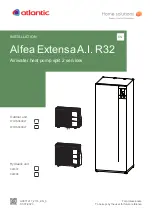
■
Electrical connections
Before performing any maintenance, make sure
that all power supplies have been cut o
ff
.
• Speci
fi
cations of electricity supply
The electrical installation must be carried out in
accordance with current regulations.
Electrical connections will only be made once all
other installation operations (fastening, assembly,
etc.) have been completed.
Warning!
The contract signed with the energy provider must
be su
ffi
cient not only to cover the heat pump’s power
requirements but also the combined sum of all the
appliances likely to be operating at the same time. If
the power is too low, check the power rating stated
in your contract with your energy provider.
Never use a power socket for the power supply.
The heat pump must be supplied directly with power
(without external switch) by special protected leads
from the electric panel via dedicated bipolar circuit
breakers, C curve for the outdoor unit, C curve for
the electrical heating* and domestic water backups*.
The electrical installation must be
fi
tted with a 30mA
RCD.
This appliance is designed to operate using a
nominal voltage of 230 V +/- 10%, 50 Hz.
Type 60245 IEC 57 or 60245 IEC 88 outside power
supply cables must be used.
• General remarks on electrical connections
It is essential to maintain neutral-phase polarity
when making electrical connections.
Rigid wires are preferable for
fi
xed installations,
particularly in a building.
Tighten the cables using the cable glands to
prevent the power cables from being accidentally
disconnected.
The earth connection and its continuity must be
ensured.
The earth wire must be longer than the other wires.
• Cable glands
To ensure the stability of power (Low Voltage) and
sensor (Extra-Low Voltage) cables, it is essential
that the cable glands are tightened according to the
following recommendations:
Size of cable
gland (mm)
Diameter of
cable
(mm)
Cable gland
tightening
torque
(check-nut)
(N.m)
Coupling net
tightening
torque
(N.m)
PG7
1 to 5
1.3
1
PG9
1.5 to 6
3.3
2.6
PG16
5 to 12
4.3
2.6
• Connecting to screw terminals
The use of ring, spade or blade terminals or
caps is prohibited.
- Always select wire that complies with current
standards.
- Strip wire end around 25 mm.
- With round end pliers, form a loop with a diameter
which matches the tightening screws on the
terminal.
- Tighten the terminal screw
fi
rmly onto the
loop created. Insu
ffi
cient tightening can cause
overheating, leading to breakdown or even
fi
re.
Rigid wire
Loop
25 mm
Spade or blade
terminal on
fl
exible wire is
prohibited
Screw
and
special washer
Terminal
• Connecting to controller boards
- Remove the corresponding connector and make
the connection.
Pre-cabled bundle connector and/or screw connector
• Connecting to spring terminals
- Strip wire end around 12 mm.
- Push the spring with a screwdriver so that the wire
enters the cage.
- Slide the wire into the opening provided for this
purpose.
- Remove the screwdriver and then check that the
wire stays gripped by the cage by pulling on it.
2
1
3




































